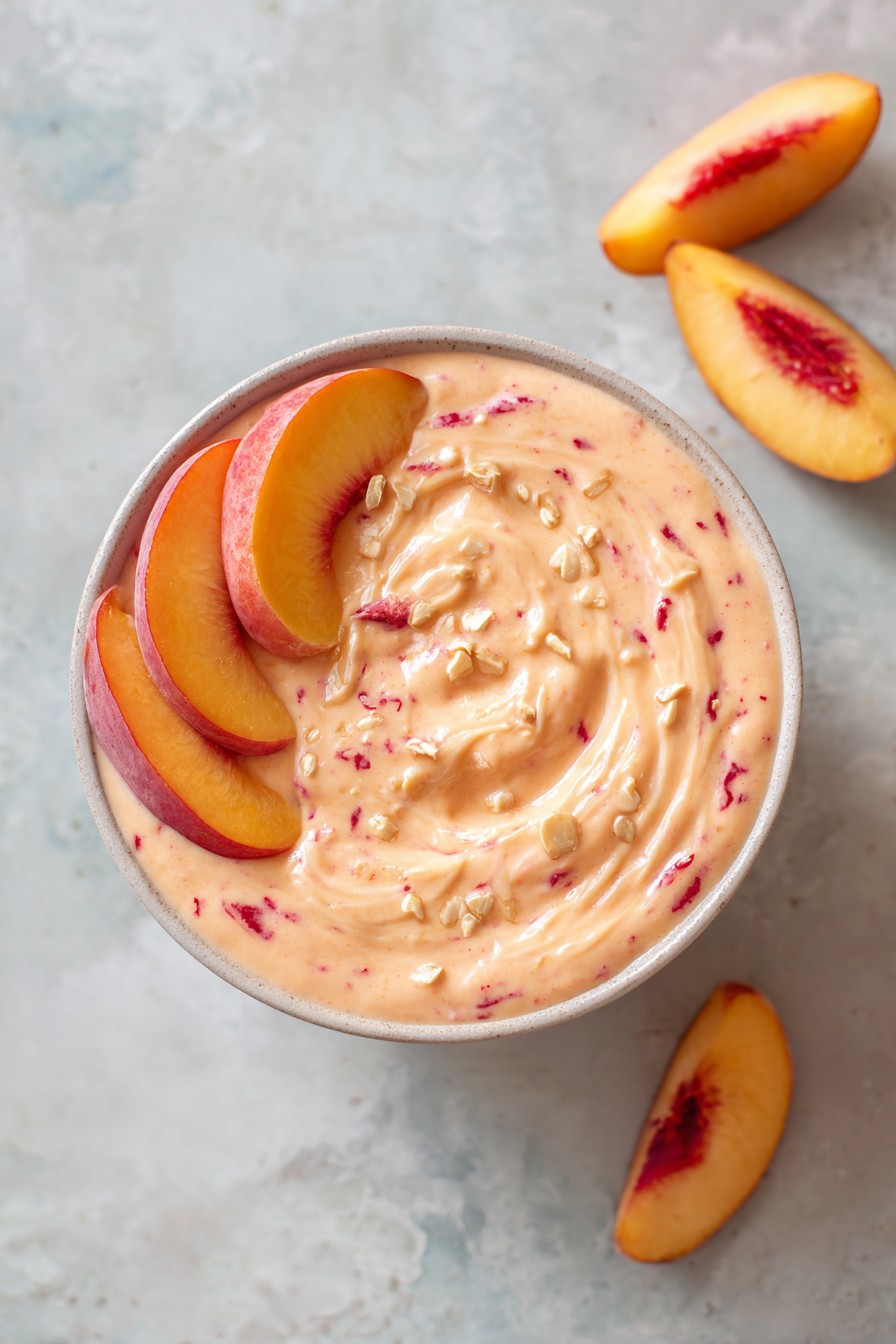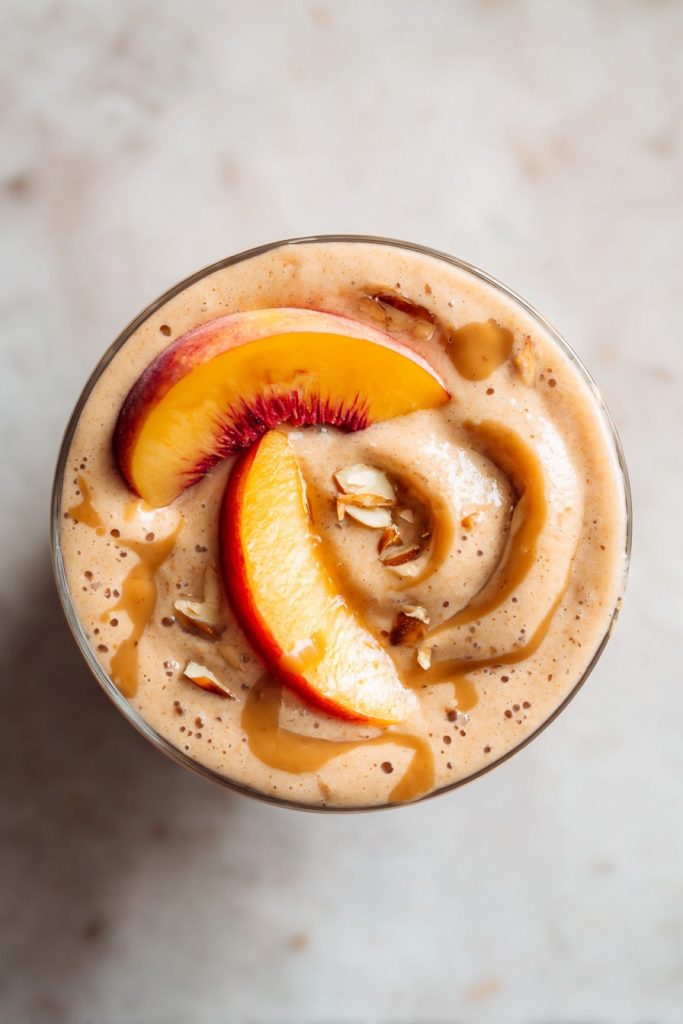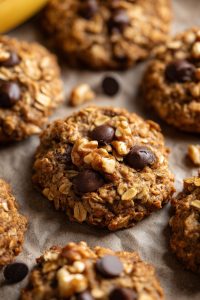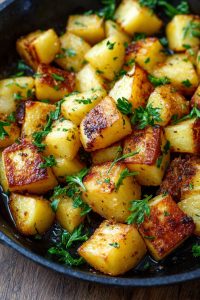Perfectly ripe peaches transform into an elegant breakfast composition when processed with technical precision. Professional chefs understand that controlling fruit temperature and emulsion stability separates ordinary smoothies from restaurant-quality bowls worthy of culinary admiration.
Why This Recipe Works
- The strategic use of frozen peaches creates optimal viscosity without diluting flavor with excess ice, allowing the natural peach essence to dominate while maintaining spoonable texture that holds decorative toppings
- Incorporating Greek yogurt provides protein structure and lactic tang that balances the stone fruit sweetness while contributing to emulsion stability through casein proteins that prevent separation
- Toasted almond butter introduces lipid complexity and mouthfeel enhancement while the subtle nutty undertones complement the peach’s floral notes without overwhelming the primary flavor profile
- Precise blending technique employing pulse-and-scrape methodology ensures uniform particle distribution while preventing oxidative degradation that can occur with prolonged high-speed blending
- The honey gradient adjustment system allows for seasonal fruit variation compensation, ensuring consistent sweetness regardless of peach ripeness fluctuations throughout the growing season
Ingredients
- 3 cups frozen peach slices (¼-inch thick)
- 1 cup plain Greek yogurt (whole milk variety)
- ½ cup unsweetened almond milk (chilled to 40°F)
- 2 tablespoons almond butter (toasted variety)
- 1 tablespoon honey (adjust to 2 tablespoons if peaches are underripe)
- 1 teaspoon vanilla extract (pure, not imitation)
- ¼ teaspoon almond extract (food-grade)
- Pinch of sea salt (fine grind)
Equipment Needed
- High-speed blender (minimum 1000-watt motor)
- Rubber spatula (heat-resistant silicone)
- Digital kitchen scale
- Instant-read thermometer
- Bowls for serving (chilled to 45°F)
Instructions

Prepare the Base Emulsion
Begin by placing 3 cups of frozen peach slices into your blender pitcher, ensuring they’re evenly distributed across the blade assembly. Add 1 cup of whole milk Greek yogurt, which provides both protein structure and lactic tang, followed by ½ cup of almond milk chilled to precisely 40°F—this temperature prevents premature thawing while facilitating smooth emulsion formation. Incorporate 2 tablespoons of toasted almond butter, positioning it near the blender walls to ensure even distribution during the initial blending phase. The strategic layering of ingredients from densest to lightest ensures optimal vortex formation and prevents motor strain. Professional tip: Weigh your peaches rather than measuring by volume for consistent viscosity batch to batch.
Develop Flavor Complexity
Drizzle 1 tablespoon of honey over the ingredient matrix, adjusting to 2 tablespoons if working with early-season peaches that lack natural sugar development. Add 1 teaspoon of pure vanilla extract and ¼ teaspoon of food-grade almond extract, strategically placing these liquid components near the blender base where they’ll immediately integrate during the blending process. Introduce a pinch of fine sea salt to heighten flavor perception and balance the stone fruit’s natural sweetness. The salt also serves to slightly depress the freezing point of the mixture, contributing to smoother texture. Begin pulsing at low speed (setting 2 on a Vitamix) for three 2-second intervals to initiate breakdown before progressing to continuous blending.
Execute Controlled Blending Technique
Increase blender speed to medium-high (setting 6 on a Vitamix) and process for exactly 45 seconds, monitoring the mixture’s temperature rise with an instant-read thermometer—target 34-36°F to maintain optimal spoonable consistency. Use the tamper to press ingredients toward the blades while maintaining constant motion to prevent air pockets. The emulsion should appear creamy with no visible peach fragments, achieving what professionals call “sherbet consistency” where the mixture holds its shape when scooped but spreads smoothly under pressure. If the mixture becomes too warm, pause blending and refrigerate for 5 minutes before continuing. This temperature control is critical for texture perfection.
Assemble with Architectural Precision
Transfer the smoothie base to bowls that have been chilled to 45°F, using a rubber spatula to scrape every bit of the precious emulsion. Pour rather than spoon the mixture to maintain air incorporation, creating a smooth surface for topping application. Work quickly to prevent temperature rise, completing the transfer within 90 seconds from blender to bowl. The ideal thickness should allow toppings to rest on the surface without sinking, indicating proper viscosity. Professional tip: Angle your bowl at 45 degrees while pouring to create an even layer distribution and aesthetically pleasing presentation foundation.
Final Temperature Stabilization
Immediately place the assembled bowls in the freezer for exactly 3 minutes to set the surface and stabilize the temperature gradient that naturally occurs during transfer. This brief exposure to sub-zero temperatures creates a slight crust that will support decorative elements while maintaining the creamy interior texture. Monitor carefully with a timer—extended freezing will compromise the desired spoonable consistency. Serve immediately after this brief stabilization period, as the emulsion begins to separate if held beyond 8 minutes post-blending. The final serving temperature should register between 28-30°F for optimal eating experience.
Tips and Tricks
For those seeking to elevate their smoothie bowl technique beyond the foundational recipe, consider these advanced professional approaches. When selecting peaches for freezing, opt for freestone varieties rather than clingstone—their flesh separates cleanly from the pit, resulting in more uniform slices that freeze consistently. Before freezing, toss peach slices in a light honey syrup (1 part honey to 4 parts water) to create a protective coating that reduces ice crystal formation and preserves cellular structure. For commercial kitchen volume preparation, consider using an anti-griddle to flash-freeze individual portions, creating perfectly textured bases that can be held at 0°F until service.
Texture modification represents another area for technical refinement. If your peaches consistently produce a thinner emulsion than desired, incorporate 1 teaspoon of xanthan gum dissolved in the almond milk before adding to the blender—this hydrocolloid stabilizer creates superior viscosity without affecting flavor. For those preferring dairy-free versions, substitute the Greek yogurt with soaked cashews (soaked for 6 hours in refrigerated water) blended with ¼ cup of the almond milk until completely smooth before adding remaining ingredients. The cashew cream provides similar emulsion stability through their natural fat and protein content.
Temperature management deserves particular attention for consistent results. Keep your blender pitcher in the freezer for 15 minutes before use to combat friction heat generation during processing. When working in warm kitchen environments, place a ice pack around the base of your blender during operation. For professional presentation, consider using liquid nitrogen to create dramatic vapor effects at service—though this requires proper safety equipment and training. Always calibrate your freezer thermometer monthly, as even a 2-degree variance can significantly impact final texture. The pursuit of perfect smoothie bowls lies in these meticulous technical details that separate amateur attempts from chef-quality creations.
Recipe Variations
- For a tropical interpretation, replace half the peaches with frozen mango and add 2 tablespoons of toasted coconut flakes to the blending stage. The mango’s higher pectin content creates naturally thicker emulsion, while the coconut introduces textural complexity. Finish with fresh passion fruit pulp and candied ginger for contrasting flavor dimensions that elevate the basic formula.
- Create a peach melba variation by incorporating ¼ cup of frozen raspberries during the final 10 seconds of blending, creating a marbled effect rather than complete integration. The raspberries’ acidity cuts through the peach’s sweetness while providing visual appeal. Garnish with fresh raspberries and slivered almonds to reference the classic dessert’s components while maintaining breakfast appropriateness.
- Develop a spiced peach version by infusing the almond milk with 1 cinnamon stick and 2 star anise pods overnight before straining. Add ¼ teaspoon of freshly grated nutmeg to the blending stage. The warming spices complement the peach’s floral notes while creating sophisticated flavor layers reminiscent of baked peach desserts without the cooking process.
- For protein-enhanced athletic recovery bowls, incorporate 1 scoop of vanilla collagen peptides and 1 tablespoon of chia seeds soaked in 3 tablespoons of almond milk for 15 minutes prior to blending. The added protein supports muscle repair while the chia seeds create gel-like consistency that provides sustained energy release throughout digestion.
Frequently Asked Questions
Can I use fresh peaches instead of frozen, and what adjustments are necessary?
While fresh peaches can be substituted, significant technique modifications are required to achieve proper consistency. Use 3 cups of peeled, pitted ripe peaches sliced ¼-inch thick and arrange them in a single layer on a parchment-lined baking sheet. Flash freeze for 2 hours until firm but not rock-solid. The partial freezing prevents complete texture breakdown during blending. You’ll need to reduce the almond milk to ¼ cup and add 1 cup of ice cubes during the final blending phase. The ice compensates for the higher water content in fresh fruit while maintaining the spoonable viscosity that defines quality smoothie bowls.
What’s the scientific reason for the specific blending times and speeds in this recipe?
The prescribed blending protocol controls two critical physical processes: oxidative degradation and emulsion stability. High-speed blending generates heat through friction, which accelerates enzymatic browning in peaches—the pulsed start minimizes this. The 45-second medium-high speed creates optimal shear force to break cell walls and release pectin while incorporating just enough air for creaminess without compromising density. Extended blending above 60 seconds overheats the mixture, causing protein denaturation in the yogurt that leads to separation. The specific parameters represent the intersection of food science and practical kitchen efficiency.
Why is Greek yogurt specified instead of regular yogurt or dairy alternatives?
Greek yogurt’s strained nature provides three technical advantages: higher protein content (specifically casein) for emulsion stabilization, reduced water content that prevents ice crystal formation, and thicker consistency that supports the structural requirements of bowl presentation. Regular yogurt contains whey that separates during freezing, while most dairy alternatives lack the protein matrix necessary for maintaining homogeneity. The lactic cultures in Greek yogurt also provide subtle tang that balances the peaches’ sweetness in a way that plant-based alternatives cannot replicate without additional acidification steps.
How can I make this recipe suitable for meal preparation?
Meal prep requires modified technique to maintain quality. Prepare the smoothie base without the almond milk, creating a thick paste that can be frozen in individual portions. Vacuum seal each portion with the measured almond milk kept separate. When ready to serve, thaw the base overnight in refrigeration, then blend with the almond milk for 30 seconds to reconstitute the emulsion. The separation prevents ice crystal damage during storage while allowing last-minute texture optimization. Prepared bases maintain quality for up to 3 weeks when frozen at 0°F or below in airtight containers.
Summary
This technically precise peach smoothie bowl recipe demonstrates how controlled temperature management and strategic ingredient layering transform simple components into restaurant-quality composition. The frozen peach foundation provides natural thickness while Greek yogurt contributes structural integrity, creating an elegant breakfast experience worthy of professional admiration.



